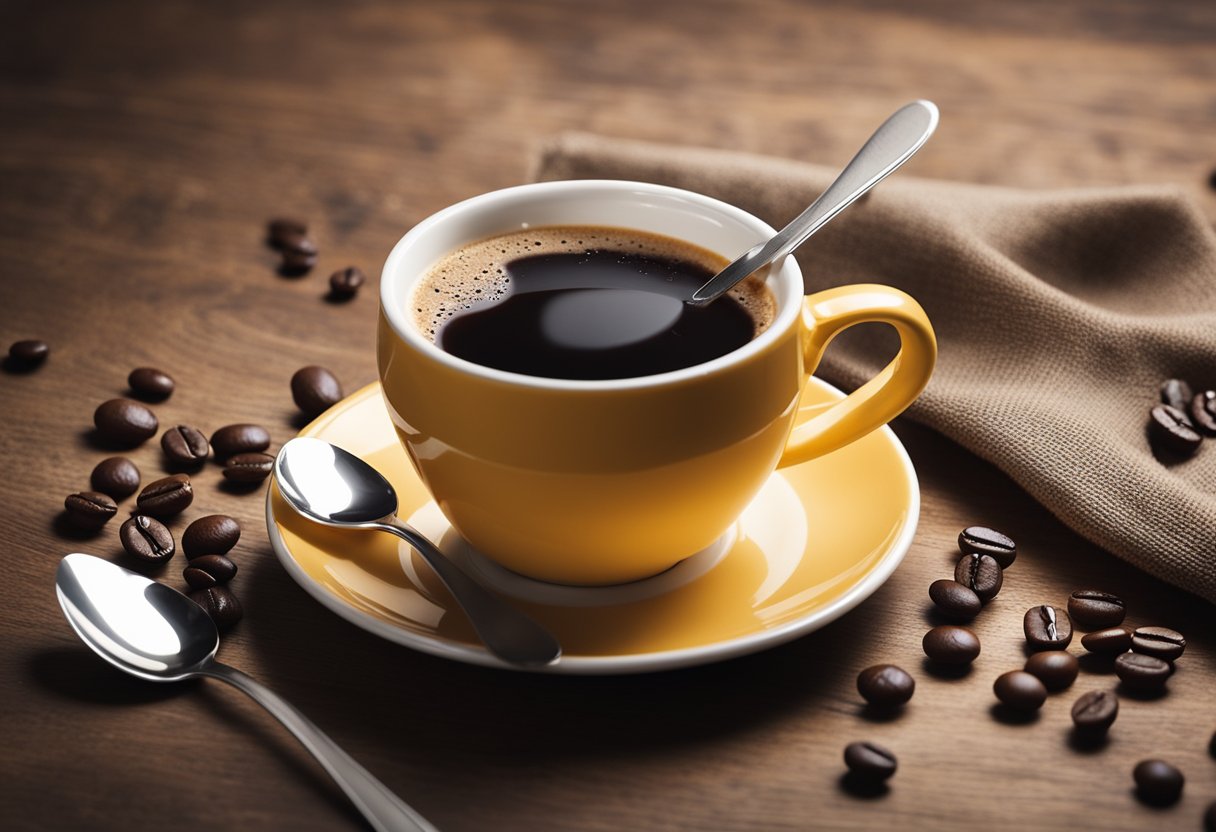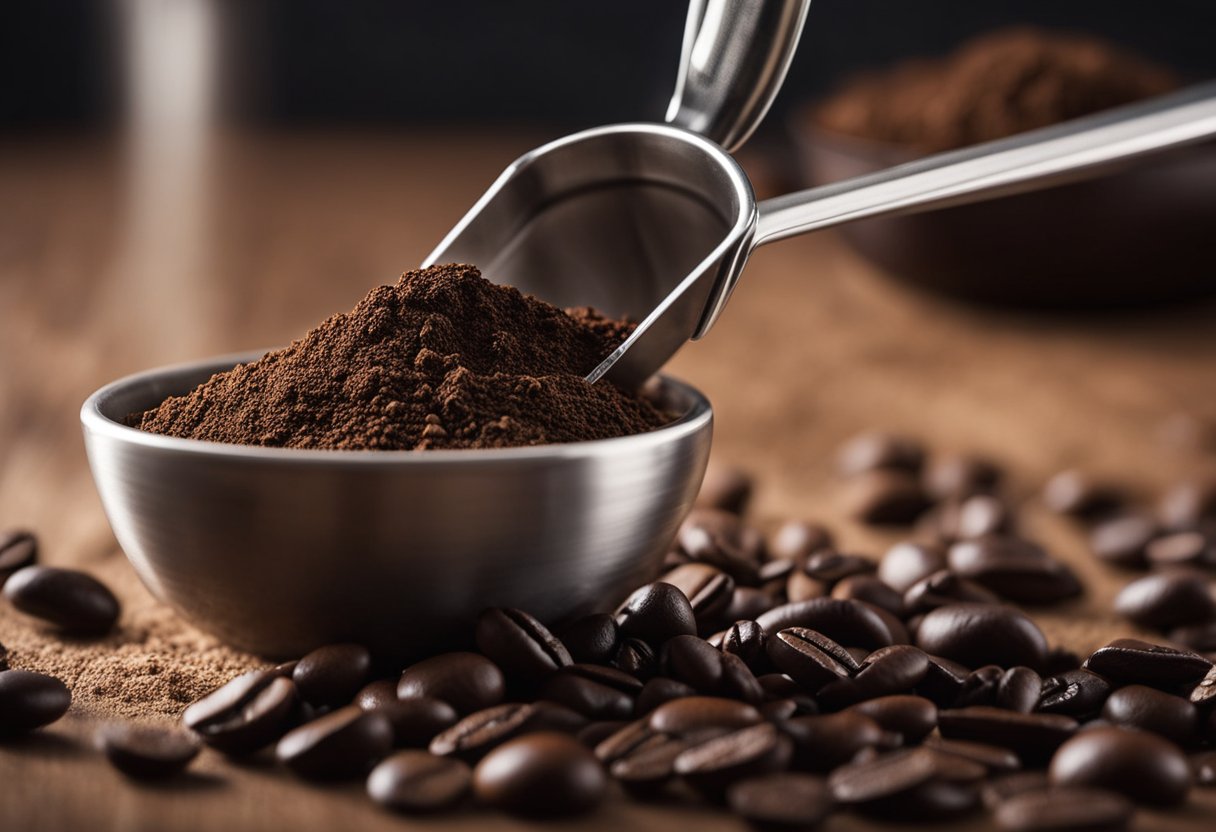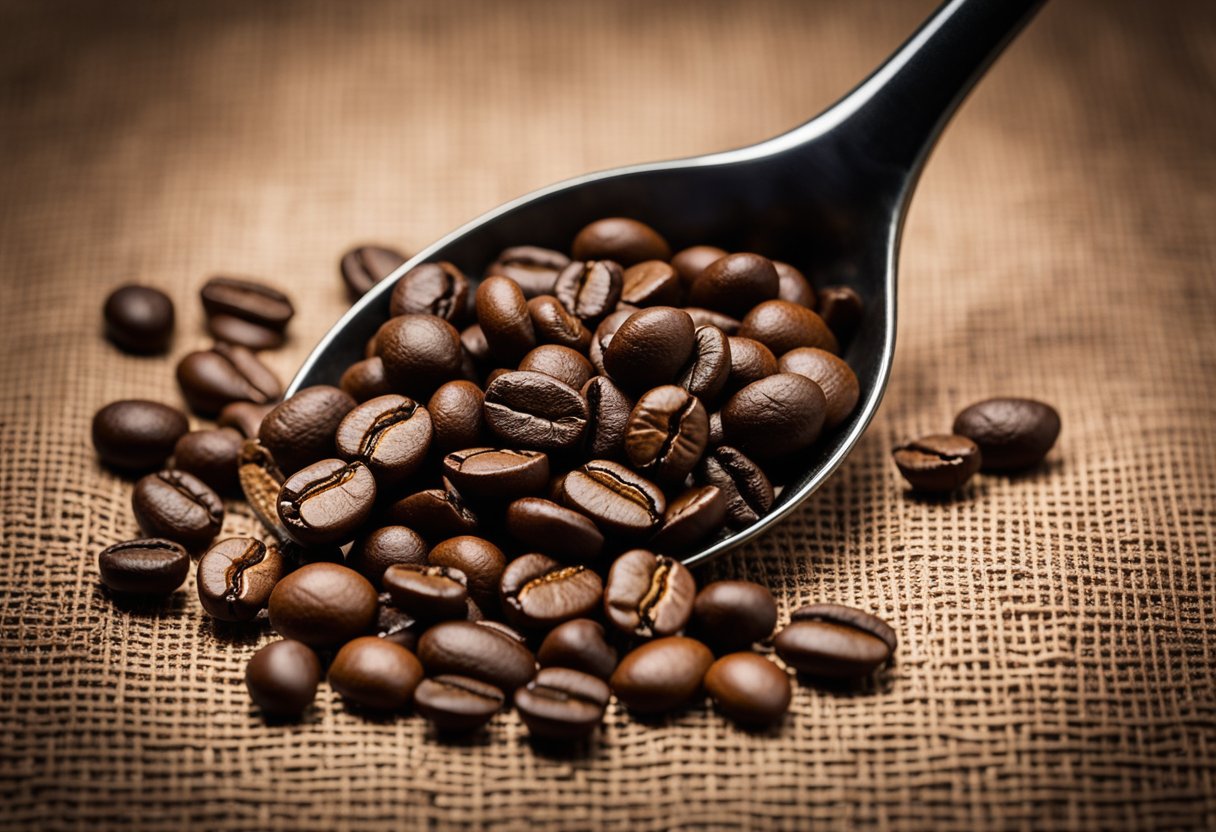1-800-982-4730
1-800-982-4730
When it comes to making a cup of coffee, there are a lot of factors to consider. One of the most important is how much coffee to use. While some people prefer to use a coffee scoop or eyeball the amount, others want a more precise measurement. This is where teaspoons come in. But how many teaspoons of coffee should you use for a cup?

The answer to this question depends on a few different factors. First and foremost is personal preference. Some people like their coffee strong and bold, while others prefer a milder taste. Another factor is the type of coffee being used. Different roasts and blends can have different strengths and flavors. Finally, the size of the cup being used will also affect the amount of coffee needed.
To help answer this question, it's important to understand the standard measurement for a cup of coffee. In general, a standard cup of coffee is considered to be 8 ounces. This means that if you're using a standard coffee mug, you'll need to measure out 2 tablespoons of coffee grounds. However, if you're using a larger or smaller cup, you may need to adjust the amount of coffee accordingly.

When it comes to making a perfect cup of coffee, it is essential to understand the measurements involved. The most common measurements used in coffee making are cups, tablespoons, and teaspoons. However, grams and fluid ounces are also used in some recipes.
A cup is a standard unit of volume measurement in cooking and baking. In coffee making, a cup is typically 8 fluid ounces or 240 milliliters. However, the size of a cup can vary depending on the recipe or the country. In some countries, a cup can be as small as 6 fluid ounces or as large as 10 fluid ounces.
Tablespoons and teaspoons are used to measure smaller amounts of ingredients. In coffee making, tablespoons and teaspoons are used to measure coffee grounds and sugar. One tablespoon is equal to three teaspoons. A standard coffee scoop is usually equivalent to two tablespoons or six teaspoons.
Grams are a unit of weight measurement used in cooking and baking. In coffee making, grams are used to measure coffee grounds and other ingredients. One tablespoon of coffee grounds is equivalent to 6 grams, while one teaspoon of coffee grounds is equivalent to 2 grams.
A kitchen scale is a useful tool for measuring coffee grounds accurately. It is especially helpful when using recipes that require precise measurements in grams. A kitchen scale can also be used to measure other ingredients, such as sugar and milk.
A fluid ounce is a unit of volume measurement used in the United States. One fluid ounce is equivalent to 29.57 milliliters. In coffee making, fluid ounces are used to measure the amount of water or milk used to brew the coffee.
The serving size of a cup of coffee is usually 8 fluid ounces or 240 milliliters. However, some coffee shops and restaurants serve larger or smaller cups of coffee. It is essential to pay attention to the serving size when calculating the amount of coffee grounds and water needed to make a perfect cup of coffee.
In conclusion, understanding coffee measurements is crucial in making a perfect cup of coffee. Whether you are using cups, tablespoons, teaspoons, grams, or fluid ounces, it is essential to measure accurately and pay attention to the serving size.

When it comes to making coffee, everyone has their own personal taste preferences. Some like their coffee strong and bold, while others prefer it mild and smooth. However, there are a few key factors to consider when making the perfect cup of coffee.
First and foremost, the amount of coffee used is crucial. A general rule of thumb is to use one to two tablespoons of coffee per six ounces of water. However, this can be adjusted based on personal taste preferences. Experimenting with different amounts of coffee can help find the optimal flavor for one's palate.
Next, the type of coffee used can greatly affect the taste. Some prefer a dark roast for a bold flavor, while others prefer a lighter roast for a smoother taste. It is also important to consider the origin and quality of the beans used.
In addition to the amount and type of coffee, the brewing method can also impact the flavor. Some prefer a French press for a full-bodied taste, while others prefer a drip coffee maker for a smoother flavor.
Finally, personal taste should always be taken into consideration. Some may prefer to add cream and sugar, while others enjoy their coffee black. Experimenting with different recipes and personal taste preferences can help find the perfect cup of coffee.
Overall, making the perfect cup of coffee is a personal and subjective process. By adjusting the amount of coffee used, experimenting with different types of coffee and brewing methods, and considering personal taste preferences, one can create a cup of coffee that is perfectly tailored to their individual palate.
Determining the right ratio of coffee to water is essential to achieving a perfect cup of coffee. The ratio refers to how much coffee is used per unit of water. The ideal coffee to water ratio is subjective and varies based on personal preference. However, a general guideline is to use two tablespoons of coffee for every six ounces of water.
The strength of the coffee can be adjusted by altering the ratio. A weaker coffee can be achieved by using less coffee per unit of water, while a stronger coffee can be made by using more coffee per unit of water.
In addition to the coffee to water ratio, the water flow can also impact the strength of the coffee. A slower water flow allows for more extraction time, resulting in a stronger cup of coffee. Conversely, a faster water flow can result in a weaker cup of coffee.
Some coffee enthusiasts swear by the "golden ratio" of 1:15, which means using one gram of coffee for every 15 grams of water. This ratio is said to produce a balanced cup of coffee, but it ultimately depends on personal preference.
Overall, experimenting with different ratios and water flows is the best way to find the perfect cup of coffee.
When it comes to brewing coffee, there are several methods to choose from. Each method has its own unique characteristics that can greatly affect the taste of the coffee. In this section, we will discuss the most common brewing methods and how many teaspoons of coffee are typically used.
The French press method, also known as a press pot or plunger pot, is a simple and popular way to brew coffee. To make coffee using this method, coarsely ground coffee beans are placed in a glass or stainless steel pot, hot water is poured over the grounds, and the mixture is left to steep for several minutes. The coffee is then pressed through a mesh filter, which separates the grounds from the liquid.
Typically, for a 4-cup French press, you would use 4-6 tablespoons of coffee, which is equivalent to 12-18 teaspoons.
Espresso is a concentrated form of coffee that is brewed by forcing hot water through finely ground coffee beans at high pressure. This method produces a strong, rich flavor that is often used as a base for other coffee drinks such as lattes and cappuccinos.
When brewing espresso, the standard amount of coffee used is 7 grams per shot, which is equivalent to approximately 2 teaspoons.
The pour-over method, also known as the drip method, involves pouring hot water over coffee grounds that are held in a filter. The water slowly drips through the grounds and into a container below. This method produces a clean and bright flavor that is often preferred by coffee enthusiasts.
For a 6-cup pour-over, you would typically use 6-8 tablespoons of coffee, which is equivalent to 18-24 teaspoons.
The Aeropress method is a relatively new brewing method that has gained popularity in recent years. This method involves steeping coffee grounds in hot water and then using air pressure to force the coffee through a filter. The result is a smooth and rich flavor that is similar to espresso.
When using the Aeropress method, the standard amount of coffee used is 17 grams, which is equivalent to approximately 5 teaspoons.
In conclusion, the amount of coffee used in each brewing method can vary depending on personal preference and the strength of the coffee desired. However, by following these general guidelines, you can ensure that your coffee is brewed to perfection.
When it comes to making coffee, there are several types of coffee available, each requiring a different amount of coffee grounds or beans per cup. Here are some of the most common types of coffee and their measurements.
Ground coffee is the most commonly used type of coffee for making drip coffee. For a standard 8-ounce cup of coffee, it is recommended to use 1 to 2 tablespoons of coffee grounds. However, the amount of coffee used can be adjusted based on personal preference.
Coffee beans are used to make coffee using a French press or other types of coffee makers. For a standard 8-ounce cup of coffee, it is recommended to use 1 to 2 tablespoons of coffee beans. However, the amount of coffee used can be adjusted based on personal preference.
Instant coffee is a quick and easy way to make coffee. For a standard 8-ounce cup of coffee, it is recommended to use 1 teaspoon of instant coffee. However, the amount of coffee used can be adjusted based on personal preference.
When it comes to choosing the right type of coffee, there are several factors to consider, including the grind size and roast level. Freshly ground coffee is always recommended for the best flavor. Additionally, the roast level can affect the amount of coffee needed per cup. Dark roasts tend to have a stronger flavor and may require less coffee, while light roasts may require more coffee to achieve the desired flavor.
In summary, the amount of coffee needed per cup can vary based on the type of coffee used and personal preference. Ground coffee and coffee beans typically require 1 to 2 tablespoons per 8-ounce cup, while instant coffee typically requires 1 teaspoon per 8-ounce cup. It is important to consider factors such as the grind size and roast level when choosing the right type of coffee.
Adjusting the strength and flavor of coffee is a matter of personal preference. Some people prefer a strong, robust cup of coffee that packs a kick, while others prefer a milder, more flavorful cup. The perfect ratio of coffee to water can vary depending on the type of coffee and the brewing method used.
For those who prefer a stronger coffee, using a higher ratio of coffee to water can help achieve a more concentrated form. A general rule of thumb is to use 1 to 2 tablespoons of coffee per 6 ounces of water. However, this can be adjusted based on personal preference. For a stronger cup, try using 2 tablespoons of coffee per 6 ounces of water.
On the other hand, for those who prefer a more flavorful cup of coffee, using a lower ratio of coffee to water can help achieve a more balanced taste. Start with a ratio of 1 tablespoon of coffee per 6 ounces of water and adjust from there.
In addition to adjusting the coffee to water ratio, other factors can also affect the strength and flavor of coffee. For example, the type of roast can impact the taste of the coffee. Lighter roasts tend to be more acidic and have a milder flavor, while darker roasts tend to be more robust and have a stronger flavor.
Overall, finding the perfect ratio and flavor of coffee is a matter of personal preference and experimentation. By adjusting the coffee to water ratio and considering other factors such as roast type, anyone can achieve a delicious cup of coffee tailored to their taste.
When using a coffee maker to brew coffee, the amount of coffee grounds used will depend on the capacity of the machine. Typically, a standard coffee maker will require one to two tablespoons of coffee grounds per six ounces of water. It is important to use a coffee scoop to measure the coffee grounds accurately. A level coffee scoop is recommended for consistent results.
Espresso machines require a different ratio of coffee to water than standard coffee makers. For a single shot of espresso, one tablespoon of coffee grounds is typically used. For a double shot, two tablespoons of coffee grounds are used. It is important to note that the grind of the coffee grounds should be fine for use in an espresso machine.
A coffee scoop is a useful tool for measuring coffee grounds accurately. There are different sizes of coffee scoops available, but a standard coffee scoop is equivalent to two tablespoons of coffee grounds. It is important to use a level coffee scoop for consistent results.
When using a coffee maker or espresso machine, precision is key to achieving the perfect cup of coffee. Using the correct amount of coffee grounds will ensure that the coffee is not too weak or too strong. It is recommended to experiment with different amounts of coffee grounds to find the perfect ratio for individual taste preferences.
After conducting several personal experiments, it's clear that the amount of teaspoons needed for a single cup of coffee can vary depending on personal preference and the size of the coffee mug. However, the Specialty Coffee Association of America recommends using 2 tablespoons or 10 grams of coffee grounds per 6 ounces of water.
It's important to note that different amounts of coffee grounds can affect the taste and strength of the coffee. Using too little coffee grounds can result in a weak and watery cup of coffee, while using too much can lead to a bitter and overpowering taste.
For those who prefer a stronger cup of coffee, they may want to experiment with using slightly more coffee grounds than the recommended amount. On the other hand, those who prefer a milder cup may want to use slightly less.
It's also worth noting that the type of coffee beans used can affect the amount of coffee grounds needed. Darker roasts generally require less coffee grounds, while lighter roasts require more.
Overall, finding the perfect amount of coffee grounds for a single cup of coffee is a personal preference that may require some experimentation. By starting with the recommended amount and adjusting from there, coffee lovers can find the perfect balance of taste and strength for their morning cup of joe.